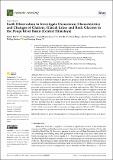Files in this item
Earth observation to investigate occurrence, characteristics and changes of glaciers, glacial lakes and rock glaciers in Poiqu River Basin (Central Himalaya)
Item metadata
| dc.contributor.author | Bolch, Tobias | |
| dc.contributor.author | Tandong, Yao | |
| dc.contributor.author | Bhattacharya, Atanu | |
| dc.contributor.author | Yan, Hu | |
| dc.contributor.author | King, Owen | |
| dc.contributor.author | Lin, Liu | |
| dc.contributor.author | Pronk, Jan B. | |
| dc.contributor.author | Rastner, Philipp | |
| dc.contributor.author | Guoqing, Zhang | |
| dc.date.accessioned | 2022-04-15T16:30:03Z | |
| dc.date.available | 2022-04-15T16:30:03Z | |
| dc.date.issued | 2022-04-15 | |
| dc.identifier | 278935419 | |
| dc.identifier | 0774fb6d-7b95-4db1-933b-8435266f61fc | |
| dc.identifier | 000787406100001 | |
| dc.identifier | 85129101049 | |
| dc.identifier.citation | Bolch , T , Tandong , Y , Bhattacharya , A , Yan , H , King , O , Lin , L , Pronk , J B , Rastner , P & Guoqing , Z 2022 , ' Earth observation to investigate occurrence, characteristics and changes of glaciers, glacial lakes and rock glaciers in Poiqu River Basin (Central Himalaya) ' , Remote Sensing , vol. 14 , no. 8 , 1927 . https://doi.org/10.3390/rs14081927 | en |
| dc.identifier.issn | 2072-4292 | |
| dc.identifier.other | ORCID: /0000-0002-8201-5059/work/111547634 | |
| dc.identifier.uri | https://hdl.handle.net/10023/25194 | |
| dc.description | This research has been supported by the Dragon 4 program funded by ESA (4000121469/17/I-NB), the Swiss National Science Foundation (grant nos. IZLCZ2_169979/1 and 200021E_177652/1) and the Strategic Priority Research Program of Chinese Academy of Sciences (grant no. XDA20100300). | en |
| dc.description.abstract | Meltwater from the cryosphere contributes a significant fraction of the freshwater resources in the countries receiving water from the Third Pole. Within the ESA-MOST Dragon 4 project, we addressed in particular changes of glaciers and proglacial lakes and their interaction. In addition, we investigated rock glaciers in permafrost environments. Here, we focus on the detailed investigations which have been performed in the Poiqu River Basin, central Himalaya. We used in particular multi-temporal stereo satellite imagery, including high-resolution 1960/70s Corona and Hexagon spy images and contemporary Pleiades data. Sentinel-2 data was applied to assess the glacier flow. The results reveal that glacier mass loss continuously increased with a mass budget of −0.42 ± 0.11 m w.e.a−1 for the period 2004–2018. The mass loss has been primarily driven by an increase in summer temperature and is further accelerated by proglacial lakes, which have become abundant. The glacial lake area more than doubled between 1964 and 2017. The termini of glaciers that flow into lakes moved on average twice as fast as glaciers terminating on land, indicating that dynamical thinning plays an important role. Rock glaciers are abundant, covering approximately 21 km2, which was more than 10% of the glacier area (approximately 190 km2) in 2015. With ongoing glacier wastage, rock glaciers can become an increasingly important water resource. | |
| dc.format.extent | 14874383 | |
| dc.language.iso | eng | |
| dc.relation.ispartof | Remote Sensing | en |
| dc.subject | Himalaya | en |
| dc.subject | Glacier changes | en |
| dc.subject | Glacier velocity | en |
| dc.subject | Geodetic method | en |
| dc.subject | Glacial lakes | en |
| dc.subject | Rock glacier | en |
| dc.subject | GB Physical geography | en |
| dc.subject | DAS | en |
| dc.subject.lcc | GB | en |
| dc.title | Earth observation to investigate occurrence, characteristics and changes of glaciers, glacial lakes and rock glaciers in Poiqu River Basin (Central Himalaya) | en |
| dc.type | Journal article | en |
| dc.contributor.institution | University of St Andrews. Environmental Change Research Group | en |
| dc.contributor.institution | University of St Andrews. Bell-Edwards Geographic Data Institute | en |
| dc.contributor.institution | University of St Andrews. School of Geography & Sustainable Development | en |
| dc.identifier.doi | 10.3390/rs14081927 | |
| dc.description.status | Peer reviewed | en |
| dc.identifier.url | https://www.mdpi.com/2072-4292/14/8/1927 | en |
This item appears in the following Collection(s)
Items in the St Andrews Research Repository are protected by copyright, with all rights reserved, unless otherwise indicated.

